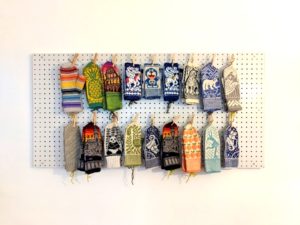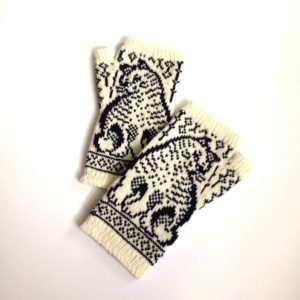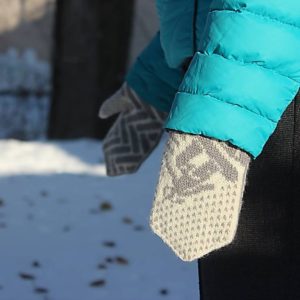I got to interview Rebecca Tsai, shinyfuzzy on ravelry, on Instagram, she’s also @shinyfuzzy.
My process for developing motifs goes like this: Pick a reference, chart the reference, knit the swatch, compare the swatch to the reference, alter the chart, repeat from 12 to 18 times. Whenever I whine, my husband asks which iteration I’m on. If it’s less than 12, he says, oh, you have a few more iterations to go that’s all.
What is your process like?
My process is similar to yours: find inspiration, chart out a design, knit, frog if necessary, repeat until it looks okay. Sometimes before frogging, I’ll throw it across the room. Most of my designs are fairly small, so I don’t bother with a formal swatch. The longest step in the process is charting – often it’ll be months of charting (off and on) and revising before I even bother knitting.
How do you choose your subjects and name them?
I try to pull my subjects from various parts of my life. I’m obsessed with pandas, and so I sketched out Reverse Panda from a photograph I took at the zoo in Tokyo. Grey Eyed, Cloud Racer, and Porcelain Cat happened because I have friends who are enamored with those animals and are constantly posting about them on social media. I also draw inspiration from travels, mythology, literature, and sports.
The names come from all sorts of places. For example, I imagine that Porcelain Cat is sitting in a parlor with floral wallpaper and a cabinet filled with fancy plates and glasses that no one is allowed to touch. But Cat knows that he is more precious and beautiful than anything in the cabinet, and he’ll touch whatever he wants! Objects in Space comes from an episode of the show Firefly. Grey Eyed comes from the Iliad and Odyssey. And some of my designs have less inspired names – Layback Spin is just a layback spin!
I love how your motif relates to the object, the proportions are harmonious. Does this make it hard to grade?
This is probably the hardest part, at least with mittens, which, unlike most things, are tall and thin. Rather than starting with any subject and forcing it to fit into a mitten, I try to choose subjects that want to be a mitten. If they don’t want to be a mitten, no amount of editing will help. I’ve found that my favorite designs are the ones that needed the least amount of work, and I think it’s largely because the proportions of the image in my head matched the object.
Most of my designs are only offered in one size, though you can knit different sizes by adjusting your gauge. Where possible, I do try to include some other options, e.g., a wider cuff or an extra chart repeat to add length. In the future, I hope to offer more sizing options.

How to you use filler patterns around your motif?
I try to come up with different filler patterns that are unique and relate back to the main design. For example, leaves on the back of Grey Eyed, mountains on the back of Glacier Melt, and clouds (or are they hoofprints?) on the back of Cloud Racer. Sometimes the relation is more abstract and can be interpreted differently by different people; e.g. on the back of Superpipe, the motif can represent mountains, snowboards, or just a geometric design.
I love how the filler patterns change on Superpipe, and indicate motion? The diagonal placement looks cool too.
Thanks! To me, those mittens are all about showing that girls can FLY!
Photography is one area I struggle with as a designer. Any tips?
It’s hard for me too! I just try to take a LOT of photos, from different angles and using different light sources, in the hope that one will be acceptable. The nice thing is that in this digital age, I don’t have to worry about wasting any film!


